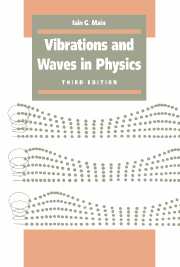Book contents
- Frontmatter
- Contents
- Preface to the first edition
- Preface to the second edition
- Preface to the third edition
- Notes for reference
- 1 Free vibrations
- 2 Free vibrations in physics
- 3 Damping
- 4 Damping in physics
- 5 Forced vibrations
- 6 Forced vibrations in physics
- 7 Anharmonic vibrations
- 8 Two-coordinate vibrations
- 9 Non-dispersive waves
- 10 Non-dispersive waves in physics
- 11 Fourier theory
- 12 Dispersion
- 13 Water waves
- 14 Electromagnetic waves
- 15 De Broglie waves
- 16 Solitary waves
- 17 Plane waves at boundaries
- 18 Diffraction
- Answers to problems and hints for solution
- Constants and units
- Index
Preface to the first edition
Published online by Cambridge University Press: 05 June 2012
- Frontmatter
- Contents
- Preface to the first edition
- Preface to the second edition
- Preface to the third edition
- Notes for reference
- 1 Free vibrations
- 2 Free vibrations in physics
- 3 Damping
- 4 Damping in physics
- 5 Forced vibrations
- 6 Forced vibrations in physics
- 7 Anharmonic vibrations
- 8 Two-coordinate vibrations
- 9 Non-dispersive waves
- 10 Non-dispersive waves in physics
- 11 Fourier theory
- 12 Dispersion
- 13 Water waves
- 14 Electromagnetic waves
- 15 De Broglie waves
- 16 Solitary waves
- 17 Plane waves at boundaries
- 18 Diffraction
- Answers to problems and hints for solution
- Constants and units
- Index
Summary
It would be generally agreed that an undergraduate course on vibrations and waves should lead the student to a thorough understanding of the basic concepts, demonstrate how these concepts unify a wide variety of familiar physics, and open doors to some more advanced topics on which they shed light. The fundamental ideas can be introduced with reference to mechanical systems which are easy to visualize and to illustrate; less tangible phenomena can then be treated with the same mathematics, leaving one free to concentrate on more interesting problems of formulation and interpretation.
In such a course there is always a risk that springs and strings will take over completely, submerging the real physics. The theory must be developed with some care and thoroughness if the student is to comprehend it in sufficient depth to be able to apply it readily, and all too often the physics has to be left half baked. This textbook is an attempt to provide, in a volume of moderate size, an account which is systematic and coherent, but which also treats the physical examples in some depth.
The diagram on p. viii shows the plan of the book, and indicates the relative weights attached to fundamental and illustrative material. The theoretical development (indicated by the downward flow through the toned areas on the left) is continuous, but is punctuated by regular excursions into physics.
- Type
- Chapter
- Information
- Vibrations and Waves in Physics , pp. xiii - xvPublisher: Cambridge University PressPrint publication year: 1993



